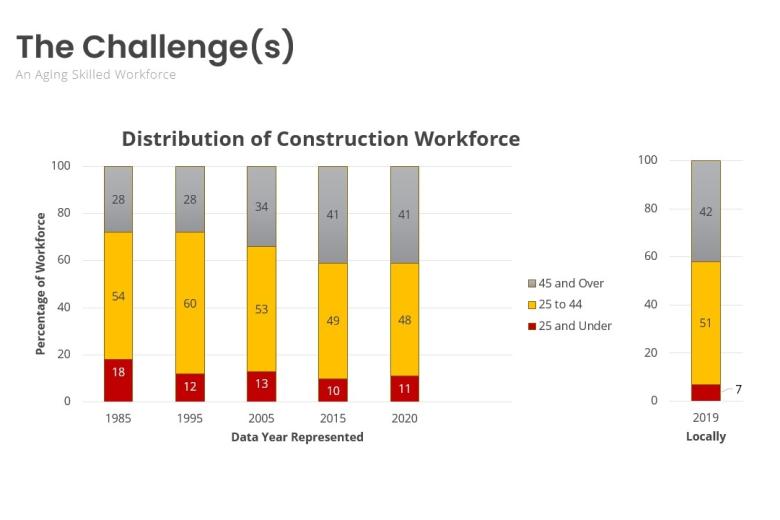Why Industry Corps?
Challenges Facing the Skilled Labor Workforce
Nationally, and further highlighted locally, there are significant challenges facing the skilled labor workforce. With the demographics shifting to a majority non-White population by 2045, the lack of diversity (racial, gender, and age) in the current skilled labor workforce has never been more important to address. Despite local policies that were created to positively influence the industry, the number of diverse residents in the local workforce has improved only slightly. To close the workforce gap, significant opportunities exist for local schools, higher education institutions, industry, and government to come together and develop solutions that grow and diversify the future skilled labor workforce.
Shortage of Skilled Workforce
America has a shortage of skilled tradespeople, an alarm that was sounded 40 years ago. Now, the same workforce is edging closer to retirement. In construction, our first pathway in Industry Corps, the estimated job growth for many occupations within the traditionally skilled workforce is at least double the anticipated growth in all industries, according to the U.S. Department of Labor. From 1985 to present, the age gap has only continued to increase as outlined in the graphic on the left.

Representation Matters
The skilled labor workforce has struggled to be representative of the racial and gender demographics, especially in urban centers like Boston. When analyzing the Boston Resident Jobs Policy (BRJP) data through a three- or four-factor demographic probability lens:
-
The probability of a 30+ year old, white, male, that lives outside of the City of Boston, on a job site in Boston, is 40.42%.
-
The probability of an 18-30-year-old, white, male, City of Boston resident on a job site in Boston is 3.38%.
-
The probability of an 18-30-year-old, person of color, male, City of Boston resident on a job site in Boston is 1.33%.
-
The probability of an 18-30-year-old, person of color, female, City of Boston resident on a job site in Boston is 0.07%.
Redefining Postsecondary Success
Postsecondary success for Boston Public School (BPS) graduates is narrowly understood as degree completion from an institution of higher education. Of the BPS graduates who attend a college or university, a little over half earn an Associates and/or Bachelors degree, representing only one-third of total BPS graduates, according to public data acquired from the Massachusetts Department of Elementary and Secondary Education (DESE). Although this data is alarming, it presents an opportunity to provide innovative, post-secondary education coupled with robust training to rebuild the workforce and help redefine postsecondary success for local youth.
